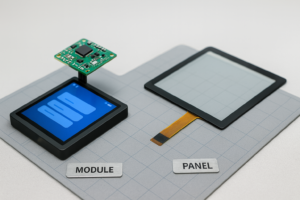Background Description
Currently, the industry primarily uses frame bonding and full lamination processes. However, frame bonding leaves an air gap, which causes light refraction and worsens optical display performance. Full lamination offers a seamless bonding process that results in superior display quality.
Phenomenon Description
Under dark display mode, after full lamination of the Cover Lens, dark room inspection reveals that the panel displays a black screen with visible white or yellowish Mura around the edges of the panel. The affected locations vary. When pressing on the center of the panel, existing Mura worsens and new Mura may appear on previously unaffected edges. After the external force is removed, the Mura does not immediately disappear.
Process Parameter Analysis
– Bonding Process:
Adjusting the flatness of the bonding platform, replacing bonding jigs, and modifying bonding pressure did not reveal any direct correlation between the Mura and the warpage of the Cover Lens or LCD. Conclusion: Full lamination Mura defects are not significantly related to the internal bonding process.
– Cross Verification:
Five good and five defective full lamination samples were disassembled into Cover Lens and panel, then reassembled in cross combinations. Results: Rebonding defective panels with good Cover Lenses still resulted in Mura. However, rebonding good panels with defective Cover Lenses did not show defects. Conclusion: Full lamination Mura defects are directly related to the panel (pane1).
Influencing Factors Analysis
– Cover Lens Thickness:
For the same product model, different glass thicknesses exhibit varying degrees of Mura severity. Thinner glass results in less noticeable Mura. Thicker glass transmits stress over longer distances, causing increased edge cell gap and more liquid crystal diffusion, resulting in yellowish Mura. Thinner glass dissipates stress through elastic deformation, reducing its propagation and resulting in minor or no Mura.
According to this stress transmission theory, panels with larger sizes tend to show lighter Mura. This is because the larger the glass, the further the stress must travel, weakening before it reaches the panel edge.
OCA Thickness
Experimental data show that, for the same OCA type, Mura defect rates decrease with increased OCA thickness. Thicker OCA has stronger anti-deformation ability and lower self-deformation, leading to reduced uneven stress and milder Mura defects.
OCA Hardness
For the same OCA type, the softer the material, the lower the Mura defect rate. Hardness reduction can lower the Mura defect rate by about 20%. Experiments also confirm that water-based adhesives cause the least Mura. This is because softer OCA better buffers external forces and produces less uneven stress. The same principle applies to the relationship between glass thickness and Mura formation.
Summary
1. Full lamination Mura is caused by uneven stress increasing the cell gap at panel edges, resulting in liquid crystal diffusion. Yellowish Mura is due to excess liquid crystal in affected areas. Sources of uneven stress include panel and Cover Lens warpage, and deformation during manufacturing, as well as stress generated during polarizer and OCA application.
2. Key influencing factors include glass thickness, OCA thickness, and OCA hardness:
– Thinner glass leads to lighter Mura
– Thicker OCA leads to lighter Mura
– Softer OCA material leads to lighter Mura
– Larger panel sizes also correlate with lighter Mura
.png)



